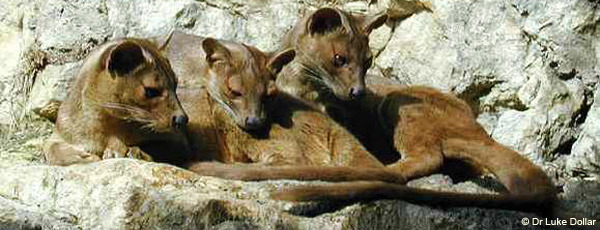Carnivores of Madagascar
- Mahajanga, Madagascar
- Volunteer Vacations

| from $2,595* per person | 13 Days | July, August, December |
| Basic accommodations | Exertion level: 3 | |
| Operator: Earthwatch Institute | 16 people max | |
Loading map, please wait...
Locations visited/nearby
Madagascar
0 testimonials about this trip.
1 testimonial about the provider, Earthwatch Institute:
-
Reviewer: L. Reifschneider
located in
St. Louis,
MO
USA
Elephant conservation is what drives my travel destinations. However, I always come home counting the blessings of new friends and an understanding of a culture and way of life I possibly would otherwise have never been introduced to. Through the Earthwatch projects I participate in, I am learning just how big and wonderful this world is.
Itinerary
Up before the sun, you’ll experience the forests of Madagascar to reach the research areas, often hiking more than 20 kilometers a day. Throughout your expedition, you’ll rotate among a variety of tasks essential to the project’s success. You'll learn how to set fosa traps and use radio-tracking transmitters and receivers, be trained to check trap lines in the early morning and late afternoon, and may help measure trapped and sedated carnivores. You’ll have a chance to spot Madagascar’s many lemur species. Midday is often free for informal lectures or hikes through the fosa's forest home. Your evenings may be spent at local village festivities or sharing stories with members of the nearby women's cooperative.You’ll stay at a tented research station with showers and toilets in Ankarafantsika National Park, Mahajanga Province, in the northwest part of Madagascar’s main island. Staff cooks will prepare local fare, based on rice and beans, topped off occasionally with exquisite, locally produced chocolates.
You’ll be based at Ampijoroa Research Station in Ankarafantsika, Mahajanga Province. The Station serves the 333,592-acre Ankarafantsika Protected Areas Complex, one of the last and largest tracts of dry deciduous forest in Madagascar. The area has more than 20 kilometers of well-marked trails that traverse through tall baobob trees, stands of precious woods such as palisandre, and many species of terrestrial and epiphytic orchids. Ankarafantsika boasts seven lemur species, including the acrobatic conquerel’s sifaka, the rare mongoose lemur, and the nocturnal woolly, sportive, and mouse lemurs. A variety of bird, reptile and amphibian species also inhabit the area.
More information from Earthwatch Institute:
- View trip on provider's website
earthwatch.org/expeditions/carnivores-of-madagascar… - Company profile, experience, and history
- View all of their trips
- Email this trip page to a friend
-



Comments from Facebook